
Fresh Water at Sea Page Menu: 1 2 3 4 5 6 7 8 9 Next>>
Fresh Water at Sea in the Golden Age of Piracy, Page 8
Fresh Water and Pirates
Several examples of the issues pirates faced in trying to get water have already been shown in the previous sections. However, pirates faced a couple of problems specific to their profession. This sometimes resulted in their using methods to obtain water which merchant and naval ships would not use.
Fresh Water and Pirates - Problems With Civilized Ports
Good locations for watering were even more limited
Artist: James Nicholls - Edward Low and the Schooner Fancy (1736)
for pirates than legitimate sailors. When Edward Low started his pirating career, he and his dozen companions decided to take "a small Vessel, and go in her, make a black Flag, and declare War against all the World."1 While this sounds romantic, it also meant they usually had to avoid well-populated locations where fresh water was known to be good and could be easily accessed. Going ashore, they ran the risk being discovered by people based on their behavior, their appearance and even their ship's appearance. If a local official found out they were pirates, he often would not even let them land.
An indirect example of this comes from Slaver Thomas Phillips' account. He explains that when they stopped at Tenerife in the Canary Islands, Phillips asked the governor if "he would permit us to furnish our selves with what fresh water and provisions we had occasion for. He reply'd, That since he was perswaded we were upon an honest account, we might furnish our selves with what e’er the island afforded"2. That phrase 'honest account' would prohibit access to known and suspected pirate vessels.
William Dampier stopped at Kupau, Timor where he made after several frustrated attempts to get water on the northwestern coast of Australia. The Governor of the Dutch fort Concordia sent a sloop manned with forty soldiers to meet his ship, telling them he was not willing to let them water there. Dampier explains, "By the small Arms my Men carried with them in the Boat, they took us to be Pirates, and would not easily believe the Account my Men gave them of what we were, and whence
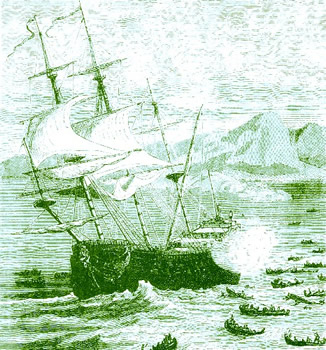
Artist: Charles Barbant
Dampier's Roebuck Under Attack off New Guinea (19th c.)
we came."3 Dampier was pretty desperate for water, so he sent his clerk to the governor the next day and, after the clerk agreed not to bring their ship too close to the fort, "assoon as we pleased, we should send our Boat full of empty Casks, and come to an Anchor with it off the Fort, till he sent Slaves to bring the Casks ashore, and fill them; for that none of our Men must come ashore."4
When captain Thomas Woolery came to Jamaica in August of 1687, he had aboard his ship the known pirate Christopher Goffe. Upon learning this, Thomas Bridge refused to let Woolery or his crew come ashore. "She then anchored, and next day Woolerly told me that he was come to wood and water, that he had Colonel Lilbourne's commission, and had done nothing contrary to it, and that he had taken in Goffe and his companions in extremity of distress. I refused him leave to come in, and he sailed away next day."5
Five ships appeared at the mouth of the Martil River near Tétouan, Morocco in September, 1721. The Weekly Mercury reported that the ships were "carrying from 30 to 50 Guns, [wanting to] take in fresh Water; but the Governor of that Place not permitting them to come a shore there, they turned towards Berion, intending to supply themselves there"6. The article explained that the ships were suspected to be Algerian pirates without explaining why. It could have been because of the unusually large number of guns the ships had. Pirate ships often had excessive numbers of guns and men as well as having their upper decks being razed or removed to make the vessel faster. If any of these things were noticed by legitimate sailors or shore men, the ship might be suspected to be a pirate.
The pirates knew this as well and sometimes made efforts to disguise themselves. When Edward Low's pirates were in need of water and they missed the relatively deserted island of Tobago, they sailed to Grenada, an island settled by the French, to get water. To hide his ship's true purpose, Low hid "most of his cutthroats below decks"7. 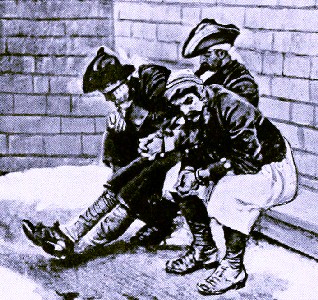
Artist: Howard Pyle - Sad, Captured Pirates (1893)
When enquiring officials sailed out to meet him, Low said he "had lost his Water; and was oblig'd to put in for a recruit; the poor People not suspecting him for a Pyrate, readily suffered him to send his Men ashoar and fetch off a supply."8
They were not quite so lucky the second time they attempted this ruse. Some of Low's pirates had taken one of their sloops to search for two ships reported to be sailing to the Cape Verde islands, but they missed these much needed prize ships. Being "reduced to great Necessities for want of Provisions and Water... they ventured to go ashore at St. Michael's [São Miguel, Azores] for a Supply, and pass for a Trader, but they play'd their Parts so aukwardly, that they were suspected by the Governor to be what they really were"9. Some Portuguese sailors recognized a few of the crew and, as Johnson glibly puts it, "the whole Crew was conduc[t]ed into the Castle [prison], where they were provided for as long as they liv'd."10
A French pirate crew was captured on a similar errand. Their ship, "whilst lying off Point de Galle [modern Galle, Sri Lanka] to procure water and provisions, was blown out to sea, leaving the boat's crew,
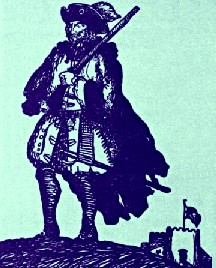
Artist: C Lovat Fraser - Standing Guard (1922)
of which [forced man Jonas] Hanway was in charge, ashore. They were taken by the Dutch and sent to Madras [India] for trial where Hanway saved his own life by turning King's evidence, the others being hanged or imprisoned."11
Even when pirates went to out-of-the-way-places to get water, they sometimes encountered problems. One example of this comes from the American colonies, a place often considered to be sympathetic to the pirates in the early part of the golden age of piracy. After a spate of piracy occurred in the bay off Lynnhaven, Virginia in the late 17th century, the locals appointed men to patrol the shores. To further discourage these pirates, Colonel John Custis
eagerly urged that a frigate should be stationed at the mouth of the only stream to be found on [Smith] island, as the one place where the pirates would be compelled to drop anchor in case they wished to go ashore. The villains, he asserted, were afraid to disembark on the mainland to secure what they needed in the way of water, wood, and provisions, as a military force could be soon raised there to beat them off.12
After a failed attempt to find the pirate ship Speaker, pirate John Cornelius brought his ship Morningstar into the Persian Gulf and settled on what they imaginatively referred to as Antelope Island because of the number of antelopes that lived there (The island was more officially referred to as Tombo during this time - shown in red at left - and is today called Tunb.)
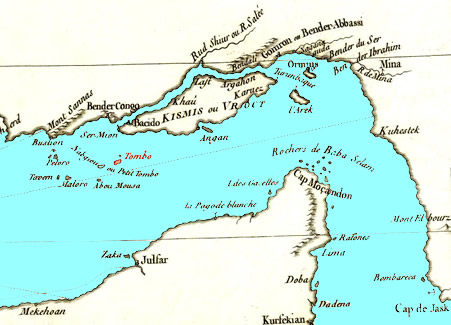
Map-Maker: Jean Baptiste Anville - Golfe Persique 1776
"Here they designed to heave down and clean, and they had got a good part of their goods and water casks ashore, when the look-out discovered two lofty ships, one of them wearing a flag at the fore-top-mast head."13 They scrambled to get what water casks they could back on the ship, waited for the two Portuguese ships to come abreast of them. Following a brief skirmish, the pirates escaped as soon as they were able and sneaked back to their careening spot on Tunb after dark. To their dismay, they found the Portuguese had landed and smashed all the casks they had left on shore.
Of course, turnabout is fair play. Historian Charles Grey explains that there were several pirate ships sailing in a very loose consortship in the East Indies during this time. The five ships involved in this loose confederacy were the William Want's Dolphin, Joseph Farrell's Portsmith Adventure, William May's Pearl, Thomas Week's Susanna and Thomas Tew's Amity.14 On at least one occasion they decided to combine their might to pay back a perceived insult. Grey explains that "the whole of the [five] Pirates combined to attack and bombard the coast town of Leet [modern Al Lith, Saudi Arabia] in revenge for the denial of water and provisions to one of them, and then thoroughly plundered that place"15.
Pirates could sometime help themselves in finding good watering locations. Pirate captain Nathaniel North was stuck aboard a prize ship that had been separated from the other ships by bad weather they were 'drove to great distress' by a lack of water on the ship. Because it was a shared problem and North had not been overly violent with them, the captives provided the solution. "The Moor merchant, who was on board with him, and whom he had treated very humanely, showed him a draught [draft, in this case a map], by which he came to a small island not far from the Dutch settlement, and watered."16
1 Captain Charles Johnson, A general history of the pirates, 2nd Edition, 1724, p. 368; 2,3 Thomas Phillips, 'A Journal of a Voyage Made in the Hannibal', A Collection of Voyages and Travels, Vol. VI, Awnsham Churchill. ed., p.185; 4 William Dampier, A Continuation of a Voyage to New-Holland, &c., Part II, 1703, p. 21-2; 5 Dampier, A Continuation, Part II, 1703, p. 27; 6 American Weekly Mercury, Vol 3, 1721-1722, The Colonial Society of Pennsylvania, 1905, p. 28; 7 David Marley, Pirates of the Americas, Vol. 2, 2010, p. 691; 8 Philip Ashton, Ashton's Memorial, 1726, p. 31; 9,10 Johnson, General History, p. 376; 11 Grey, p. 72; 12 Philip Alexander Bruce, Institutional History of Virginia in the Seventeenth Century, 1910, p. 216 13 Johnson, History of the Pirates, p. 194; 14,15 Grey, p. 158; 16 CSPC America and West Indies, Vol. 12, Item 1449;
Fresh Water and Pirates - Problems With Forced Men
A key aspect of piracy was the ability of a pirate crew to intimidate other crews into surrendering. Since most merchant ships were minimally manned to save money, the more men a pirate had, the more likely a targeted merchant ship would surrender without a fight. A merchant ship's crew were usually just employees of the owners, so they were not often willing to risk their lives for someone else's property. In order for this to work, however, the pirates needed a lot of men. The penalty for piracy was death, resulting in pirates sometimes having trouble getting willing recruits. They sometimes forced other sailors aboard who did not want to join them to bolster their numbers. Such 'forced men' usually sought means of escape. Making landfall to procure water and other provisions could present them with such an opportunity.
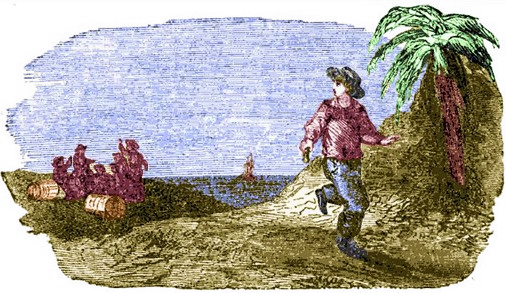
Philip Ashton's Escape, From De Nieuwe Robinson Crusoë (1850)
Philip Ashton, captive of Edward Low's crew, provides one of the most detailed descriptions of how this could be accomplished. When Low's ship stopped at Roatan, Honduras, Ashton convinced the ship's cooper to take him with them to get fresh water from the island. Ashton seized his opportunity:
When we came first to Land, I was very Active in helping to get the Casks out of the Boat, & Rowling them up to the Watering place; then I lay down at the Fountain & took a hearty Draught of the Cool Water; & anon, I gradually strol' d along the Beech, picking up Stones & Shells, & looking about me; when I had got about Musket Shot off from them (tho' they had taken no Arms along with them in the Boat) I began to make up to the Edge of the Woods1
The cooper spotted Ashton, asking him where he was going. He replied that he was going to get coconuts. That must have satisfied the cooper, because Ashton then slipped into the woods. Once he was out of sight "I betook my self to my Heels, and ran as fast as the Thickness of the Bushes and my naked Feet would let me."2 On discovering Ashton's disappearance, the cooper called for him several times and finally decided that he had gotten himself lost. "So finding it in vain for them to wait any longer, they put off with their Water, without me; and thus was I left upon a desolate Island destitute of all help, and much out of the way of all Travellers”3.
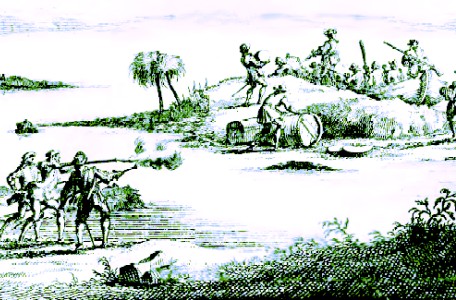
Artist: Pieter van der Aa
Shooting at Sailor's Watering, From De Seer Aanmerklijke en Vermaarde (1706)
An even more dramatic example of what could happen when the forced men escaped occurred when pirate captain Thomas Anstis stopped to careen his brigantine at the Bay of Honduras in March of 1723. Four or five men led by forced man and former merchant vessel captain Richard Dursey managed to steal some of the pirates weapons and escape from the pirates, hiding on shore.
When the pirates finished careening their brig, they prepared to leave by sending their canoe ashore for water. When they came ashore, Dursey "ventur’d to take the Canoo and secure the men; at which the Pirates mann’d their Boat well, and sent her on Shore, but with the same Success, for they [Dursey and company] took her and secured all the men"4. Now enraged, the pirates sent a larger boat containing around 30 men to get them, "but Capt. Dursey and Company gave them so warm a Reception, that they were glad to betake themselves to their Vessel again."5 As a result, the pirates not only lost four or five forced men, but a number of regular pirates as well.
1 Philip Ashton, Ashton's Memorial, 1726, pp. 41-2; 2 Ashton, p. 42; 3 Ashton, p. 43; 4,5 New England Courant, 3-11-23 - 3-18, Issue 84
Fresh Water and Pirates - Coercing and Stealing Water
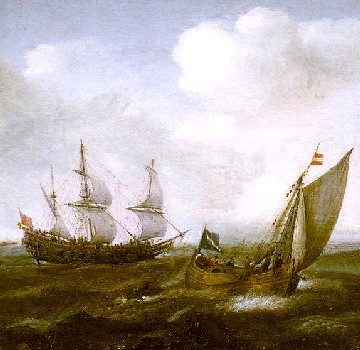
Artist: Hendrick Cornelisz Vroom - Ship and Fishing Boat (1628-30)
Water seems like an odd thing to pirate, but as shown in this article, it is a precious commodity at sea. As a result, pirates sometimes found it expedient to employ pressure to determine where water could be found on land rather than try to convince civilized people and ports to let them get water. Nathaniel North's pirates tried to capture a fishing boat to find out how where they could get good water, but the men in the fishing vessel jumped overboard and most of them swam to shore. North's men chased one of them, accidentally breaking his jaw during the chase. They took the man to their surgeon and give him a pipe of tobacco and some liquor, after which he told them about a well on shore. The pirates were only able to get 3 buckets of water from the well, causing them to threaten to kill the wounded fisherman. He "told them, if they would have patience till the sun was set, they would have plenty, for the spring would rise, and flow all night; which they found to be the fact, and filled twenty tons [tuns] of water, and returned on board, carrying the man with them, for whom they made a gathering of some goods, and about 30 dollars."1
A death threat to another fisherman played a part when Edward Low's pirates were seeking water. Low's
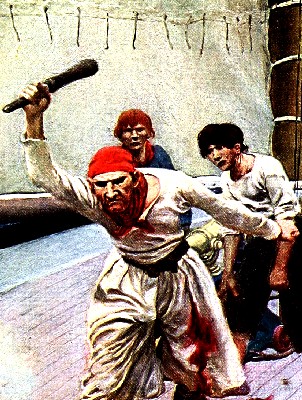
Artist: Howard Pyle - Then the Real Fight Began (1911)
crew had captured a fishing boat with two men and a boy on board off the Portuguese island of Madeira. In an effort to get water, they sent one of the fishermen "ashore with a Flag of Truce, demanding a Boat of Water of the Governor, on Pain of taking away the old Man's Life, whom they threatened to hang at the Yard-Arm"2. When the governor complied, the pirates let the three of them go, being "much handsomer cloathed than when they took them."3
Another trio of men were similarly treated after being taken off a small ship at anchor by pirate captain John (Richard) Taylor at a time where his crew needed to refresh their supply of fresh water. "They sent one of these [three men] on Shore to the Captain [of the small Ship], to acquaint him, if he would supply them with some Water, and fresh Provisions, he should have his Ship again"4. The master of the ship agreed to the terms, but the man delivering the message joined the pirate crew and convinced them that the master's offer was 'collusive' resulting in their deciding to seek water elsewhere.
Edward Low's pirates captured seven ships off of St. Michaels in Maryland in 1722. After plundering the ships, and taking one for their own use, "Low then sent word to the Governor at St. Michaels, that if furnished with supplies he would release the vessels that had been taken, otherwise they would be burned."6 The governor decided it was best to give the pirates what they wanted and they released the remaining six vessels.
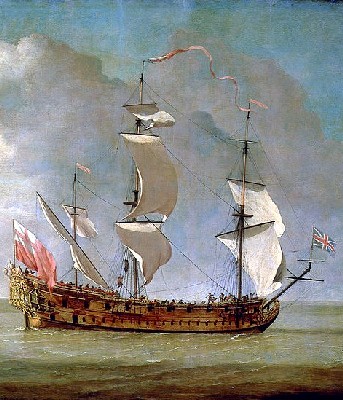
Artist: Willem Van de Velde the Younger
The Charles Galley, Similar to Kidd's Adventure Galley (late 17th c.)
When William Kidd was searching for water in the East Indies he had trouble getting anyone to give it to him. The word had been passed around the area that his pirate hunting voyage had turned into a piracy voyage by the East India company, making him an unwanted visitor. In October of 1697, Kidd anchored off Calicut (modern Kozhikode) where he sent a message via a local fishermen to shore requesting wood and water. They refused to talk with him. He sent a boat ashore with a letter which was to 'end all suspicion' and asking "for wood and water which if you will please to enorder, I shall honestlie satisfie [pay] for"7. Receiving no response, he sailed "to the small port of Bhatkal where he forcibly procured all that he required by plunder and violence."8 So much for ending all suspicion.
Several pirates stole water from the vessels they captured. Captain Wallice Fensilon reported that he had been taken by Bartholomew Roberts "who took from ‘em eight Hogsheads of Rum, a Tearce of Sugar, their Cloaths, Bedding, Books, Instruments, their best Cable, and all their Water, except upon a Barrel"9. In similar fashion, Edward Low caught the Carteret sailing out from Carolina in 1724. The pirates "plunder’d her of all her Water and Beer, and took away the Master’s Cloaths, Money &c. which oblig’d him to put back again for a new Supply."10
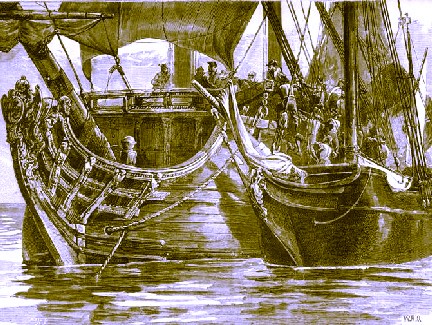
Boarding, From The Sea, Volume 3, By Frederick Whymper (1877)
When pirate captain Thomas White's crew captured the ship Jay at St. Mary's Island off Madagascar and then "they took water casks and other necessaries"11. Pirate captain John James similarly took several casks of water out of the Roanoke, which was captured in Lynnhaven Bay, Virginia. Adding insult to injury, James' crew ordered the commander of the Roanoke "to fetch a large quantity of fresh water kept in the flyboat [another ship they had captured], but the tide preventing him from returning promptly, the buccaneer leader, becoming impatient, set out in person to bring both him and the water back"12. Edward Low's crew took James Cahoon's mainsail, provisions and water when they captured his sloop near the Rhode Island coast.13 Richard Chivers "took the brigantine Amity, for her water casks, sails, rigging and masts, and then turned the hull adrift to run upon a reef and be lost."14
1 Captain Charles Johnson, The History of the Pirates, 1829, p. 164; 2 Johnson, History of the Pirates, p. 197; 3,4 Johnson, General History, p. 373; 5 Johnson, General History, p. 128; 6 George Francis Dow and John Henry Edmonds, The Pirates of the New England Coast 1630-1730, 1996, p. 153; 7,8 Charles Grey, Pirates of the Eastern Seas (1618-1723), 1971, p. 201; 9 Applebees Original Weekly Journal, 1-21-21; 10 Weekly Journal or Saturdays Post, 8-24-23, Issue 252; 11 Captain Charles Johnson, The History of the Pirates, 1829, p. 108; 12 Philip Alexander Bruce, Institutional History of Virginia In the Seventeenth Century, Volume II, 1910, p. 212-3; 13 Dow & Edmonds, p. 147-8; 14 Charles Grey, Pirates of the Eastern Seas (1618-1723), 1971, p. 120

